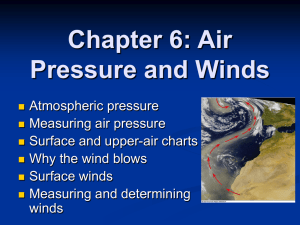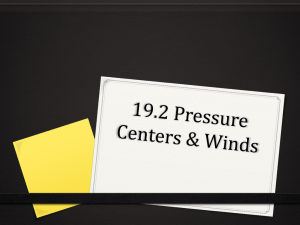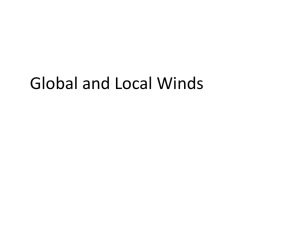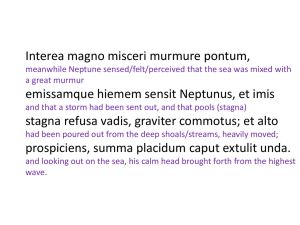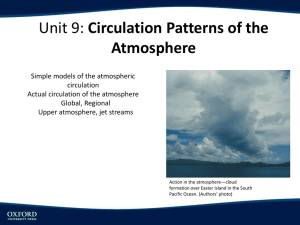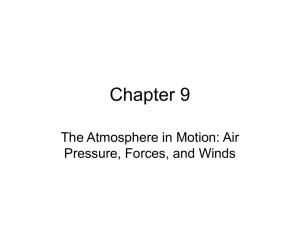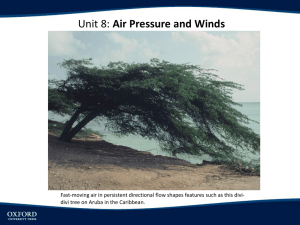Lecture 23
advertisement
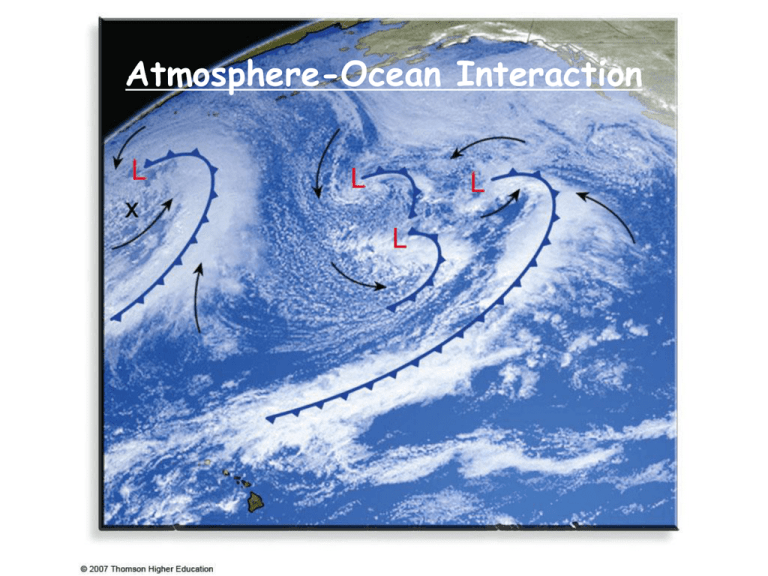
Atmosphere-Ocean Interaction Upcoming Schedule • Thursday, March. 14: Exam review in class • Tuesday, March. 19: Second midterm exam. The exam will cover Chapters 19, 6, 7, 8, and 10 from the 9 edition of the book. th ♦ Closed book No textbooks, calculators or formula sheets. ♦ Alternate (anti-social) seating ♦ Bring a picture ID to the exam. ♦ Remember to: Write the 5-digit test code in lines 76-80 Write your name on the exam sheet and sign it • • • • The Single Cell Model This is a very simplified model based on the following three assumptions: 1. The Earth’s surface is uniformly covered with water (no differential heating of the land and the oceans) 2. The sun is always directly over the equator (no seasonal variations of the winds). 3. The Earth does not rotate. ♦ No Coriolis effect. ♦ The only active force is the pressure gradient force. Observing global winds from space Intertropical convergence zone • The Three Cell Model Keep two of the assumptions, relax the third: ♦ The Earth is covered with a continuous ocean ♦ The sun is always directly over the equator ♦ The Earth rotates -> Coriolis force! Three cell model: the Hadley cell (0-30 deg) • Thermally direct cell: warm air rises, cool air sinks • Intertropical Convergence Zone (ITCZ) ♦ A.k.a. equatorial doldrums • ♦ Warm air, weak PGF, light winds, cumulus clouds and thunderstorms ♦ Air rises up to the tropopause, then laterally toward the poles ♦ Deflected east due to the CF ♦ Winds aloft in NH: from southwest Subtropical highs (anticyclones) ♦ Equatorial air cools, sinks, warms up, clear skies -> major deserts ♦ Air converges (follow the meridians on a globe) – high surface pressure ♦ Horse latitudes: small PG, weak horizontal winds -> sailors get stuck ♦ Surface winds in NH: from the northeast (Trade winds) Three cell model: the Ferrel cell (30-60 deg) • Thermally indirect cell: cool air rises and warm air sinks ♦ Some of the sinking air in the horse latitudes heads toward the pole ♦ Deflected east by the CF ♦ Surface winds in NH: from the southwest (westerlies) ♦ At the polar front the westerlies encounter cold air moving down from the poles ♦ Air is forced to rise, some of it returns to the horse latitudes, completing the Ferrel cell, the rest heads for the pole ♦ Upper air winds in the Ferrel cell: from the northeast. William Ferrel William Ferrell Three cell model: the polar cell (60-90 deg) • It is a Hadley type of circulation. • ♦ Surface winds: from the north east (polar easterlies) ♦ Upper winds in NH: from the southwest Summary: two major areas of Low pressure (ITCZ and subpolar low), and two of High pressure (poles and subtropical highs) The converging/diverging regions • ITCZ (Intertropical Convergence Zone ) - Equator • • • ♦ Low surface pressure with small PG and weak horizontal winds. ♦ Upward motion of warm moist air. Results in convective cloud towers Subtropical highs (the horse latitudes) – 30N; 30S ♦ High surface pressure ♦ The upper air is sinking, warms up and the relative humidity is very low. ♦ Weak winds, clear sky, dry climate – large deserts at these latitudes. Subpolar lows (polar front) – 60N, 60S ♦ A converging zone at the surface. Air moves up and results in strong storms. ♦ Weak winds Polar highs – 90N, 90S • • The General Circulation and Precipitation Paterns Converging surface flows: ♦ Low surface pressure ♦ Uprising air ♦ Heavy precipitation Diverging surface flows: ♦ High surface pressure ♦ Sinking air ♦ Dry climate • • Winds and pressure in the real world Semi-permanent highs and lows: persist throughout the year, correspond to converging/diverging upper air masses. ♦ Bermuda, Pacific highs; Icelandic, Aleutian lows Seasonal highs and lows (continents heat/cool faster) ♦ Winter: Siberian high, Canadian high ♦ Summer (thermal lows): Southwest US, Iran January July Subtropical highs Subtropical highs Does it work? • • (continents heat/cool faster) • • Yes: semi-permanent highs and lows: persist throughout the year No: seasonal highs and lows No: seasonal shifts N-S (today) No: winds aloft in mid latitudes January July Subtropical highs Subtropical highs Effect on the local climate • • • During summer, the Pacific high moves north near the CA coast, and the Bermuda high moves closer to the SE coast. CA: dry summers GA: wet summers Seasonal Effects on the Global Circulation. • The three cell model neglects the Earth’s tilt • The tilt would cause seasonal N-S shifts • Bright white colors correspond to stronger winds. • The winds are stronger in the winter. • The wind system shifts slightly north-south during the year (think of bird migration) January July Winds and Pressure Systems Aloft • The wind system aloft differs from the surface wind system. It is close to a geostrophic flow. • There is no significant friction with the ground. • The three cell model does not work that well in the middle latitudes. • The winds aloft are stronger than on the ground. • In the winter the gradients are bigger -> the winds are stronger. July January Winds Aloft • Warm air above the equator and cold air above the polar regions • Higher pressure at the equator, lower pressure both to the north and to the south of the equator • The pressure gradient force is towards the poles, sets the air in motion • The Coriolis force • • • ♦ NH: to the right ♦ SH: to the left The wind turns right in the NH and left in the SH, becomes parallel to the isobars Westerly winds aloft in both the NH and SH. Easterly winds at the surface in both the NH and SH. Atmosphere-Ocean Interaction • The surface of the Earth impacts the air motion through the friction force. • Newton’s III law: for every action there is a reaction. The atmosphere exerts a friction (drag) force on the surface of the Earth. • The prevailing surface winds drive the surface currents in the oceans. • Variations in the surface temperature of the ocean impacts the atmospheric T as well as amount of the water vapor in the atmosphere. • •• Major ocean currents Gyres: circular whirls of ocean currents ♦ 25-40 deg angle b/n wind and current Clockwise in the North Pacific and Atlantic Counterclockwise in the South Pacific and Atlantic Ekman Spiral • The surface winds drive the surface currents. • The friction force acting on the ocean surface is in the direction of the wind. • The Coriolis force deflects the current to the right (NH). • Each layer of water drags • • the water layer below, and the Coriolis force pushes the moving water below to the right. The direction of the ocean current changes with depth. The net mass transport within the first 100 m is perpendicular to the wind direction. • • • Upwelling of the Ocean Water Winds plowing along the coastal line result in a net surface current perpendicular to the wind and away from the coast. The warm surface water is replaced by an upwelling deep cold water. Water upwelling explains the low water temperatures along the California coast. • Surface Water Temperature Along California’s Coast The low water temperatures result in low saturation vapor pressure over the ocean. • example from Chapter 5 • Recall the advection fog As the air moves over the land the air warms up and results in low relative humidity. • The summer is very dry.


